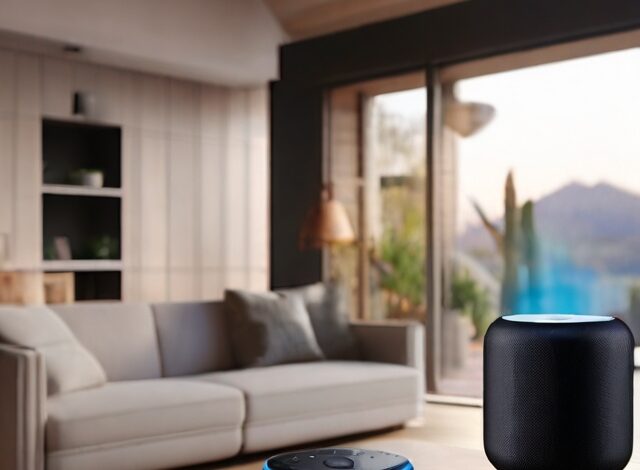Comparing voice assistant technologies for home automation

Introduction
The landscape of home automation has been revolutionized with the advent of voice assistant technologies. As smart homes become more prevalent, the role of voice assistants as the central interface for controlling a myriad of devices has grown exponentially. From adjusting thermostats to managing security systems, these technologies offer unparalleled convenience and efficiency.
The choice of a voice assistant is crucial and highly personal. It depends on a variety of factors including compatibility with other devices, the level of privacy one desires, and specific features that cater to individual lifestyles. This article aims to provide a detailed comparison of the leading voice assistant technologies – Amazon Alexa, Google Assistant, and Apple Siri, among others – to help you make an informed decision for your smart home needs.
Overview of Key Voice Assistants in the Market
In the current market, several key players dominate the voice assistant landscape. Amazon Alexa, Google Assistant, and Apple Siri are at the forefront, but there are also emerging technologies that are worth noting.
Amazon Alexa, launched in 2014, has become synonymous with voice-controlled smart devices. It operates on Amazon Echo devices and a host of third-party products. Alexa’s main strength lies in its vast array of “Skills” – add-ons that allow users to customize their experience and control a wide range of smart home devices.
Google Assistant, Google’s foray into the voice assistant market, is renowned for its deep integration with Google’s services like search, maps, and Gmail. Available on Google Home devices and various third-party offerings, it stands out for its ability to process natural language, making interactions more conversational and intuitive.
Apple Siri, the pioneer in voice assistant technology, is known for its integration across Apple’s product line, including iPhones, iPads, and HomePods. Siri places a high emphasis on user privacy and data security, appealing to those who are security-conscious.
Other notable mentions include Microsoft’s Cortana, Samsung’s Bixby, and several region-specific assistants that are gaining popularity in local markets. Each of these assistants has been developed with a specific user demographic in mind, focusing on different aspects of the user experience and device integration.
The evolution of these technologies reflects a broader trend in consumer electronics and home automation – a shift towards more intuitive, personalized, and seamless interactions with technology. As we progress, the competition among these voice assistants is not just about understanding commands but also about understanding the user, their habits, and preferences, and integrating smoothly into their daily lives.
Technical Capabilities and Features
When comparing the technical capabilities and features of voice assistants, it’s crucial to focus on aspects like voice recognition accuracy, processing speed, and the range of functionalities offered.
Voice Recognition and Processing Speed:
- Amazon Alexa is known for its robust voice recognition, especially in noisy environments. Its processing speed is commendable, handling commands swiftly.
- Google Assistant excels in understanding natural language, making it more adept at processing complex queries. Its integration with Google’s search algorithms allows it to provide more accurate responses.
- Apple Siri offers reliable voice recognition, particularly for users deep within the Apple ecosystem. Siri’s processing speed is optimized for Apple’s hardware, ensuring a seamless experience.
Unique Features and Functionalities:
- Amazon Alexa’s Skills are a standout feature, allowing users to add functionalities ranging from ordering food to controlling smart home devices. This customization makes Alexa incredibly versatile.
- Google Assistant offers superior integration with Google’s suite of services, like Google Calendar, Maps, and Photos, providing a more holistic experience.
- Apple Siri focuses on privacy and seamless integration across Apple devices. Features like Siri Shortcuts allow users to create personalized voice commands.
Compatibility with Smart Home Devices:
- Amazon Alexa supports a vast array of smart home devices, making it a popular choice for a diverse smart home ecosystem.
- Google Assistant also boasts wide compatibility but excels in integrating with Google’s own smart home devices, like Nest products.
- Apple Siri, through HomeKit, focuses on secure and private integration with smart home devices, though its range of compatible devices is more limited compared to Alexa and Google Assistant.
The technical prowess of these voice assistants is a key determinant in their applicability in home automation. As they evolve, we see a constant improvement in their ability to process and understand human language, making interactions more natural and intuitive.
User Experience and Accessibility
The user experience and accessibility of voice assistants are paramount, as these technologies are often used by a diverse range of individuals, including those with disabilities.
User Interface and Ease of Use:
- Amazon Alexa offers a user-friendly interface, with its app being straightforward to navigate. Its voice commands are simple, making it accessible to users of all ages.
- Google Assistant stands out with its conversational interaction style, which can make users feel like they’re talking to a human rather than a machine.
- Apple Siri integrates seamlessly with other Apple products, offering a unified experience across devices. Siri’s user interface is intuitive, especially for those already familiar with the Apple ecosystem.
Accessibility Features:
- Amazon Alexa has features like voice profiles and the ability to understand different accents and dialects, making it accessible to a wider audience.
- Google Assistant offers features like Interpreter Mode for real-time translation, which is invaluable for non-native speakers or in multilingual households.
- Apple Siri provides robust accessibility features, particularly for those with visual or hearing impairments, through its integration with Apple’s accessibility settings.
User Reviews and Feedback:
- Amazon Alexa generally receives positive reviews for its wide range of skills and easy integration with other devices.
- Google Assistant is often praised for its ability to handle complex queries and its natural conversational style.
- Apple Siri receives mixed reviews, with praise for its privacy and security features but criticism for a more limited range of compatible devices.
User experience and accessibility are critical, as they directly impact how effectively and comfortably users can interact with their voice assistants. These factors often become the deciding factor for many users when choosing a voice assistant for their home.
Privacy and Security
The privacy and security aspects of voice assistants are a major concern for many users, especially given the sensitive nature of data processed by these devices.
Amazon Alexa:
- Alexa has faced scrutiny over privacy concerns, particularly regarding data storage and how voice recordings are used.
- Amazon has responded by introducing features like the ability to delete recordings and more transparent privacy settings.
Google Assistant:
- Similar to Alexa, Google Assistant has faced questions about how it handles user data, especially considering Google’s extensive data collection across its services.
- Google has made efforts to enhance privacy controls, including options to auto-delete activity and providing clear privacy policies.
Apple Siri:
- Apple positions Siri as the more privacy-focused option, emphasizing local data processing and minimal data retention.
- Siri’s integration within the Apple ecosystem is designed to enhance security and privacy, though this comes at the cost of some functionality compared to its rivals.
Privacy and security are critical in the age of smart homes, as these devices have access to a lot of personal information. The balance between functionality and privacy is a key consideration for users when selecting a voice assistant.
Cost and Value
When considering the cost and value of voice assistants, it’s important to look beyond the initial price of the hardware to consider the overall value offered in terms of features, compatibility, and user experience.
Amazon Alexa:
- Alexa-enabled devices range from affordable to high-end, offering options for different budgets.
- The value proposition of Alexa lies in its extensive compatibility with a wide range of devices and the vast library of skills available.
Google Assistant:
- Google Assistant devices are similarly priced to Alexa, with options available across various price points.
- The Assistant’s integration with Google services and its natural language processing capabilities offer significant value, especially for users already invested in the Google ecosystem.
Apple Siri:
- Siri is available on Apple devices, which are generally priced higher, reflecting Apple’s premium branding.
- The value of Siri is in its seamless integration across Apple devices and its focus on privacy and security, appealing to loyal Apple users.
The cost of voice assistants is not just monetary; it also includes considerations of privacy, compatibility, and the ecosystem you are buying into. Understanding these aspects helps in making an informed decision that aligns with both budget and personal preferences.
Future Trends and Developments
The future of voice assistant technologies is likely to be influenced by advancements in AI, machine learning, and user interface design.
- Advancements in AI and Machine Learning: These will lead to more natural interactions, better understanding of context and user preferences, and proactive assistance.
- Integration with Other Technologies: Voice assistants are expected to integrate more deeply with other smart home technologies and IoT devices, leading to more cohesive and automated home environments.
- Focus on Privacy and Security: As user awareness about data privacy grows, companies will likely place greater emphasis on developing secure and privacy-conscious voice assistants.
- Expansion into New Markets and Languages: Voice assistants will continue to expand their reach, supporting more languages and dialects, and catering to a global audience.
- Innovations in Hardware: We might see new form factors and more sophisticated hardware designs that blend more seamlessly into home environments.
These trends indicate a future where voice assistants become even more integral to our daily lives, offering enhanced convenience, improved accessibility, and smarter home automation.
Conclusion
In conclusion, the choice of a voice assistant for home automation depends on a variety of factors including technical capabilities, user experience, privacy concerns, and budget. Amazon Alexa excels in compatibility and customizability, Google Assistant in intelligent responses and integration with Google services, and Apple Siri in privacy and seamless integration within the Apple ecosystem. As these technologies continue to evolve, they will undoubtedly offer even more advanced features, improved user experiences, and stronger privacy safeguards. Ultimately, the best voice assistant for you will align with your specific needs, preferences, and lifestyle.
FAQ:
Q1: What are voice assistants and how do they work in home automation?
A1: Voice assistants are AI-powered software that respond to voice commands. In home automation, they control smart devices, manage tasks, and provide information, all through voice interaction.
Q2: Which voice assistants are the most popular for home automation?
A2: The most popular voice assistants for home automation are Amazon Alexa, Google Assistant, and Apple Siri. Each offers unique features and integrations with smart home devices.
Q3: Can these voice assistants control all smart home devices?
A3: While these voice assistants are compatible with many smart home devices, not all devices are supported by every assistant. Compatibility depends on the brand and technology of the smart home device.
Q4: How do voice assistants impact user privacy?
A4: Voice assistants can raise privacy concerns as they process voice commands and sometimes record interactions. Each service has different policies and settings for data handling and privacy.
Q5: Are there any costs associated with using these voice assistants?
A5: While the voice assistant services are generally free, you need compatible hardware (like smart speakers) to use them. Some features or integrations may also require subscriptions or additional purchases.
Q6: Can voice assistants understand different languages and accents?
A6: Major voice assistants like Alexa, Google Assistant, and Siri support multiple languages and accents, though the extent of support can vary.
Q7: How do these voice assistants differ in terms of user accessibility?
A7: The assistants vary in user interface, ease of use, and accessibility features. For instance, Siri is known for its integration with Apple’s accessibility tools, while Google Assistant excels in natural language processing.



